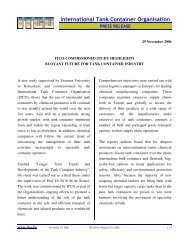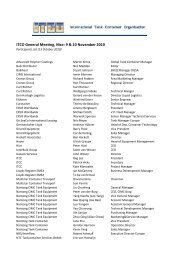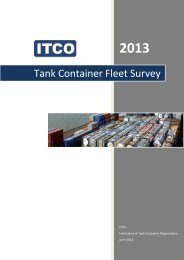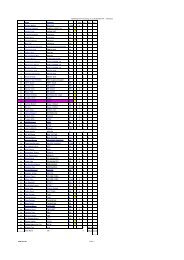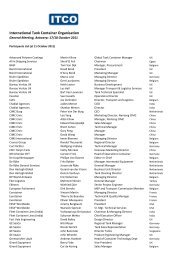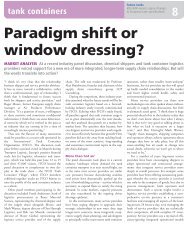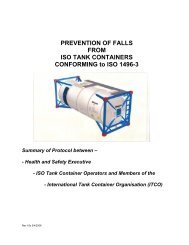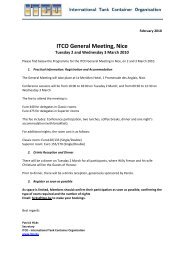You also want an ePaper? Increase the reach of your titles
YUMPU automatically turns print PDFs into web optimized ePapers that Google loves.
ICHCA International <strong>Safe</strong>ty Panel Briefing Pamphlet No 30<br />
6.2.7.3 It is also important that all fittings, especially<br />
discharge valves, should not protrude<br />
outside <strong>of</strong> the envelope formed by the outer<br />
faces <strong>of</strong> the corner fittings. Picture 45 shows<br />
a bottom discharge valve that has the end <strong>of</strong><br />
the valve protruding outside <strong>of</strong> the end<br />
frame. There is a severe risk <strong>of</strong> the valve<br />
being damaged and some <strong>of</strong> the cargo<br />
being released. Such containers should<br />
not be shipped.<br />
Picture 45<br />
6.2.7.4 On large capacity tank containers, the outlet valve handle <strong>of</strong>ten protrudes<br />
outside the end frame when open. It is most important that outlet valves on<br />
tank containers where this can happen are closed before the tank is handled<br />
and transported. Serious damage to outlet assemblies and even tank<br />
shells may occur if handles protruding beyond the frame are struck, for<br />
example by another container being placed next to it.<br />
6.2.8 <strong>Tank</strong> Frames<br />
6.2.8.1 The design <strong>of</strong> tank frames are such<br />
that the in the event <strong>of</strong> a catastrophic<br />
failure <strong>of</strong> the frame as a result <strong>of</strong> the<br />
container being knocked <strong>of</strong>f a stack or<br />
the tank container being involved in a<br />
roll-over accident, the pressure vessel<br />
will remain intact as shown in Picture<br />
46<br />
6.3 Operational <strong>Safe</strong>ty<br />
Picture 46<br />
6.3.1 Under no circumstances should lifting <strong>of</strong> tank containers by fork lift<br />
truck be attempted. The only exception to this may be in the case <strong>of</strong>,<br />
for example, <strong>of</strong>f-shore 10 foot tank containers fitted with properly<br />
designed and maintained fork lift pockets.<br />
6.3.2 Many <strong>of</strong> the fittings and fixtures attached to the tank container can protrude<br />
outside <strong>of</strong> the ISO envelope when they are open or erected such as:<br />
Leaving temporarily fitted steam traps on the outlet pipes <strong>of</strong> steam<br />
coils<br />
Wrapping electric cables <strong>of</strong> heating systems around corner posts in<br />
stead <strong>of</strong> placing these in the proper holder or tray<br />
Leaving temporary adaptors on airline connections<br />
Not closing manway lids full after use<br />
Not closing top outlet valve handles<br />
Not closing airline valves on top <strong>of</strong> tanks<br />
Waterlogged insulation material causing it to sag and/or bulge outside<br />
the allowable external dimensions<br />
Collapsible handrails not properly stowed away<br />
Note: Where any item protrudes outside <strong>of</strong> the envelope the tank<br />
container must not be shipped<br />
Page 25 ©ICHCA International Limited



